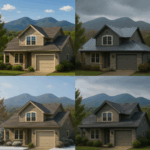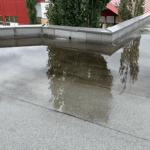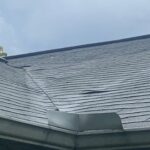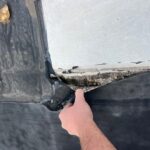How to Make Homeowners Insurance Cover a New Roof Replacement
If you’re a homeowner in Asheville, North Carolina, and you’re dealing with an aging or storm-damaged roof, you’re not alone.
Getting your homeowners insurance to cover a new roof can be a complex but achievable goal if you understand the right steps to take.
In this guide, we’ll explore effective strategies to make insurance cover a new roof replacement, supported by statistics, references, and insights specific to North Carolina.

When Insurance Covers Roof Replacements
Homeowners insurance is designed to protect your property from unexpected damages. However, not all roof-related issues qualify for coverage. Generally, insurance will cover a roof replacement if the damage is due to “perils” specified in the policy. Typical covered perils include hail, windstorms, fire, and lightning.
Key Points for Insurance Coverage on Roofs:
Natural Events: If a storm or other natural event has damaged your roof, you are more likely to qualify for coverage.
Neglect and Wear: Insurance policies do not cover routine wear and tear or damage caused by a lack of maintenance.
Material and Age Limits: Some insurers consider the material and age of your roof, often reducing or denying claims for older roofs over 15-20 years.
Steps to Get Your Insurance to Cover a New Roof
1. Review Your Homeowners Insurance Policy
The first step is to thoroughly review your homeowners insurance policy. Look specifically for sections on roof coverage and “named perils.” In North Carolina, where heavy rainfall, hail, and windstorms are common, understanding these clauses can provide clarity on what’s covered.
2. Document Damage Immediately
Roof damage must be documented immediately to strengthen your case. If you delay, insurers may argue that the damage worsened due to negligence.
Key Documentation Tips:
Take Photos and Videos: Document visible damage on your roof, shingles, gutters, and even interior damage (e.g., water stains).
Get a Roof Inspection: Hire a local Asheville roofing contractor to perform a professional inspection and provide an estimate. A third-party inspection report can support your claim by outlining specific areas of damage caused by insurable events.
3. File a Claim Promptly
Timing is crucial when dealing with insurance claims for roof replacements. Most insurers set strict time limits for filing claims, especially for storm-related damages. In North Carolina, filing within a week of the event is advisable.
What to Include in Your Claim:
Detailed Description: Outline how the damage occurred and the specific event (e.g., storm, hail).
Inspection Reports: Include findings from your roofing contractor’s inspection.
Cost Estimates: Providing repair and replacement estimates shows the insurer the financial need for covering a new roof.
Common Reasons Claims Are Denied and How to Avoid Them
Insurance companies often deny claims for roof replacements due to various reasons. Here are the top reasons and strategies to help you avoid them.
1. Roof Age and Pre-existing Conditions
Older roofs, especially those over 20 years, are often excluded from full replacement coverage. If your roof is old, insurers may only pay a depreciated amount based on its age.
Solution: Request an “endorsement” on your policy to ensure you receive full replacement value. This may slightly increase premiums but guarantees more coverage in the event of damage.
2. Inadequate Maintenance
Insurers may deny claims if they find evidence of neglect, like missing shingles or mold, indicating the homeowner failed to maintain the roof properly.
Solution: Schedule regular roof inspections, especially after Asheville’s intense weather seasons. Keep records of these inspections and any repairs, as they show you have maintained the roof responsibly.
3. Failure to Provide Adequate Proof
Failing to provide comprehensive documentation is a frequent cause for claim denial.
Solution: Be prepared with detailed documentation, as described above, including dated photos, videos, and inspection reports.
Roof Damage Statistics in North Carolina
North Carolina experiences significant weather events that impact roofs across the state. According to the Insurance Information Institute (III), hailstorms alone cost homeowners nearly $14 billion annually in the U.S., with North Carolina among the top 10 states affected by hail damage.
In Asheville specifically, data from the National Weather Service indicates that an average of 20+ severe thunderstorms impact the region annually, with associated risks including high winds, hail, and even tornadoes. These statistics underscore why roof insurance claims are common in Asheville and highlight the importance of understanding your insurance policy.
How Roofing Materials and Construction Impact Coverage
The type of roofing material and construction quality can influence the extent of insurance coverage. For example:
Asphalt Shingles: Common but tend to have shorter lifespans. Insurance companies may depreciate claims faster if your roof is older.
Metal Roofs: Durable and resistant to many natural hazards, metal roofs may be favored by insurers for their longevity.
Slate and Tile: Known for longevity but costly to repair; some policies might cover only a portion of replacement costs.
Pros and Cons of Using Insurance for a New Roof
| Pros | Cons |
|---|---|
| Cost Savings: Reduces or eliminates out-of-pocket expenses for repairs. | Premium Increases: A claim may increase your premium in subsequent years. |
| Professional Repairs: Ensures that you can afford professional roofing services. | Limited Coverage: Policies might not cover older or poorly maintained roofs fully. |
| Faster Repairs: Insurance claims expedite the repair process after a storm. | Deductibles Apply: You’ll still pay a deductible before full coverage kicks in. |
| Enhanced Home Value: Replacing a damaged roof with insurance can boost property value. | Claim Denial Risk: If improperly filed, claims can be denied due to lack of proof. |
FAQs on Getting Insurance to Cover a New Roof Replacement
It depends. Many insurers reduce or deny claims for roofs older than 15-20 years. Policies with replacement cost value (RCV) rather than actual cash value (ACV) offer better coverage for older roofs.
Document all visible damage immediately, schedule an inspection, and file a claim promptly. Hail is generally covered by most policies.
Consider appealing the decision with additional documentation or consult a public adjuster who specializes in insurance claims.
Approval times vary, but generally, claims are processed within 15-30 days. Complex claims may take longer.
Yes, you’ll need to meet your policy’s deductible before receiving full coverage.
Not necessarily; it depends on your policy details and the severity of the storm damage.
Yes, in most cases, you can choose your preferred contractor. However, some insurers have preferred contractors for expedited service.
For Asheville residents, an annual inspection is ideal, particularly after storm seasons.
Metal roofs are often preferred by insurers due to their durability, while asphalt shingles provide moderate coverage options due to affordability.
Get Insurance Cover For A New Roof
Understanding your homeowners insurance policy and taking proactive steps can increase your chances of getting insurance to cover a new roof. If you’re in Asheville and need further guidance, consult a trusted local roofing company that specializes in insurance claims for North Carolina homeowners. The expertise of an Asheville roofing contractor can make a significant difference in navigating the insurance claim process successfully.





